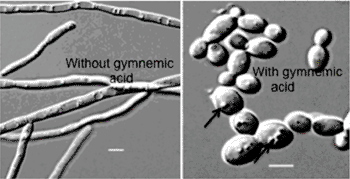Gymnemic Acids Stabilize the Yeast Form of Candida albicans and Enhance Action of Antifungal Drugs
|
By LabMedica International staff writers Posted on 24 Sep 2013 |

Image: Leaves of the medicinal plant Gymnema sylvestre (Photo courtesy of Wikimedia Commons).

Image: Gymnemic acids prevent C. albicans yeast-to-hyphal transition and hyphal growths. Scale bars: five micrometers (Photo courtesy of Kansas State University).
Small molecules isolated and purified from leaves of the ancient medicinal plant Gymnema sylvestre inhibit yeast-to-hypha conversion and hyphal growth in the fungus Candida albicans, which greatly enhances the effect of antifungal drug treatments.
Candida albicans is a diploid fungus that grows both as yeast and filamentous cells and is a causal agent of opportunistic oral and genital infections in humans. Systemic fungal infections, including those by C. albicans, have emerged as important causes of morbidity and mortality in immunocompromised patients. Furthermore, C. albicans biofilms may form on the surface of implantable medical devices, while hospital-acquired infections by C. albicans have become a cause of major health concerns.
Investigators at Kansas State University (Manhattan, USA) isolated and purified gymnemic acids (GAs) from Gymnema sylvestre. They reported in the September 11, 2013, online edition of the journal PLOS ONE that purified GAs had no effect on the growth and viability of C. albicans yeast cells but inhibited its yeast-to-hypha conversion under several hypha-inducing conditions, including the presence of serum. Moreover, GAs promoted the conversion of C. albicans hyphae into yeast cells under hypha inducing conditions. In a model system, GAs inhibited the formation of invasive hyphae from C. albicans-infected Caenorhabditis elegans worms and rescued the worms from being killed by the fungus.
In addition to their effects on C. albicans, GAs also inhibited conidial germination and hyphal growth of another fungus, Aspergillus.
"We have shown that this compound is safe to use because it does not hurt our body cells, yet it blocks the virulence of this fungus under in vitro conditions," said senior author Dr. Govindsamy Vediyappan, assistant professor of biology at Kansas State University. "Taking the medicine could potentially help patients control the invasive growth of the fungus."
C. albicans also makes a biofilm that can be difficult to treat. The investigators found that the gymnemic acid compounds converted the biofilm back to treatable yeast cells.
"This compound prevents the biofilm formation because hyphae are the major builders of biofilms and biofilms are resistant to antifungals," said Dr. Vediyappan. "Yeast cells by themselves cannot make biofilms and are sensitive to antifungal treatments."
Related Links:
Kansas State University
Candida albicans is a diploid fungus that grows both as yeast and filamentous cells and is a causal agent of opportunistic oral and genital infections in humans. Systemic fungal infections, including those by C. albicans, have emerged as important causes of morbidity and mortality in immunocompromised patients. Furthermore, C. albicans biofilms may form on the surface of implantable medical devices, while hospital-acquired infections by C. albicans have become a cause of major health concerns.
Investigators at Kansas State University (Manhattan, USA) isolated and purified gymnemic acids (GAs) from Gymnema sylvestre. They reported in the September 11, 2013, online edition of the journal PLOS ONE that purified GAs had no effect on the growth and viability of C. albicans yeast cells but inhibited its yeast-to-hypha conversion under several hypha-inducing conditions, including the presence of serum. Moreover, GAs promoted the conversion of C. albicans hyphae into yeast cells under hypha inducing conditions. In a model system, GAs inhibited the formation of invasive hyphae from C. albicans-infected Caenorhabditis elegans worms and rescued the worms from being killed by the fungus.
In addition to their effects on C. albicans, GAs also inhibited conidial germination and hyphal growth of another fungus, Aspergillus.
"We have shown that this compound is safe to use because it does not hurt our body cells, yet it blocks the virulence of this fungus under in vitro conditions," said senior author Dr. Govindsamy Vediyappan, assistant professor of biology at Kansas State University. "Taking the medicine could potentially help patients control the invasive growth of the fungus."
C. albicans also makes a biofilm that can be difficult to treat. The investigators found that the gymnemic acid compounds converted the biofilm back to treatable yeast cells.
"This compound prevents the biofilm formation because hyphae are the major builders of biofilms and biofilms are resistant to antifungals," said Dr. Vediyappan. "Yeast cells by themselves cannot make biofilms and are sensitive to antifungal treatments."
Related Links:
Kansas State University
Latest BioResearch News
- Genome Analysis Predicts Likelihood of Neurodisability in Oxygen-Deprived Newborns
- Gene Panel Predicts Disease Progession for Patients with B-cell Lymphoma
- New Method Simplifies Preparation of Tumor Genomic DNA Libraries
- New Tool Developed for Diagnosis of Chronic HBV Infection
- Panel of Genetic Loci Accurately Predicts Risk of Developing Gout
- Disrupted TGFB Signaling Linked to Increased Cancer-Related Bacteria
- Gene Fusion Protein Proposed as Prostate Cancer Biomarker
- NIV Test to Diagnose and Monitor Vascular Complications in Diabetes
- Semen Exosome MicroRNA Proves Biomarker for Prostate Cancer
- Genetic Loci Link Plasma Lipid Levels to CVD Risk
- Newly Identified Gene Network Aids in Early Diagnosis of Autism Spectrum Disorder
- Link Confirmed between Living in Poverty and Developing Diseases
- Genomic Study Identifies Kidney Disease Loci in Type I Diabetes Patients
- Liquid Biopsy More Effective for Analyzing Tumor Drug Resistance Mutations
- New Liquid Biopsy Assay Reveals Host-Pathogen Interactions
- Method Developed for Enriching Trophoblast Population in Samples
Channels
Clinical Chemistry
view channel
AI-Powered Blood Test Accurately Detects Ovarian Cancer
Ovarian cancer ranks as the fifth leading cause of cancer-related deaths in women, largely due to late-stage diagnoses. Although over 90% of women exhibit symptoms in Stage I, only 20% are diagnosed in... Read more
Automated Decentralized cfDNA NGS Assay Identifies Alterations in Advanced Solid Tumors
Current circulating cell-free DNA (cfDNA) assays are typically centralized, requiring specialized handling and transportation of samples. Introducing a flexible, decentralized sequencing system at the... Read more
Mass Spectrometry Detects Bacteria Without Time-Consuming Isolation and Multiplication
Speed and accuracy are essential when diagnosing diseases. Traditionally, diagnosing bacterial infections involves the labor-intensive process of isolating pathogens and cultivating bacterial cultures,... Read more
First Comprehensive Syphilis Test to Definitively Diagnose Active Infection In 10 Minutes
In the United States, syphilis cases have surged by nearly 80% from 2018 to 2023, with 209,253 cases recorded in the most recent year of data. Syphilis, which can be transmitted sexually or from mother... Read moreMolecular Diagnostics
view channel
POC Oral Swab Test to Increase Chances of Pregnancy in IVF
Approximately 15% of couples of reproductive age experience involuntary childlessness. A significant reason for this is the growing trend of delaying family planning, a global shift that is expected to... Read more
Microbial Cell-Free DNA Test Accurately Identifies Pathogens Causing Pneumonia and Other Lung Infections
Bronchoalveolar lavage (BAL) is a commonly used procedure for diagnosing lung infections, especially in immunocompromised patients. However, standard tests often fail to pinpoint the exact pathogen, leading... Read moreHematology
view channel
First Point-of-Care Heparin Monitoring Test Provides Results in Under 15 Minutes
Heparin dosing requires careful management to avoid both bleeding and clotting complications. In high-risk situations like extracorporeal membrane oxygenation (ECMO), mortality rates can reach about 50%,... Read more
New Scoring System Predicts Risk of Developing Cancer from Common Blood Disorder
Clonal cytopenia of undetermined significance (CCUS) is a blood disorder commonly found in older adults, characterized by mutations in blood cells and a low blood count, but without any obvious cause or... Read moreImmunology
view channel
Stem Cell Test Predicts Treatment Outcome for Patients with Platinum-Resistant Ovarian Cancer
Epithelial ovarian cancer frequently responds to chemotherapy initially, but eventually, the tumor develops resistance to the therapy, leading to regrowth. This resistance is partially due to the activation... Read more
Machine Learning-Enabled Blood Test Predicts Immunotherapy Response in Lymphoma Patients
Chimeric antigen receptor (CAR) T-cell therapy has emerged as one of the most promising recent developments in the treatment of blood cancers. However, over half of non-Hodgkin lymphoma (NHL) patients... Read moreMicrobiology
view channel
New Blood Test Detects Up to Five Infectious Diseases at POC
Researchers have developed a prototype flow-through assay capable of detecting up to five different infections, with results that can be quickly analyzed and transmitted via a specialized smartphone app.... Read more
Molecular Stool Test Shows Potential for Diagnosing TB in Adults with HIV
Tuberculosis (TB), caused by the bacterium Mycobacterium tuberculosis, led to 1.25 million deaths in 2023, with 13% of those occurring in people living with HIV. The current primary diagnostic method for... Read morePathology
view channel
Groundbreaking Chest Pain Triage Algorithm to Transform Cardiac Care
Cardiovascular disease is responsible for a third of all deaths worldwide, and chest pain is the second most common reason for emergency department (ED) visits. With EDs often being some of the busiest... Read more
AI-Based Liquid Biopsy Approach to Revolutionize Brain Cancer Detection
Detecting brain cancers remains extremely challenging, with many patients only receiving a diagnosis at later stages after symptoms like headaches, seizures, or cognitive issues appear. Late-stage diagnoses... Read moreTechnology
view channel
Advanced Predictive Algorithms Identify Patients Having Undiagnosed Cancer
Two newly developed advanced predictive algorithms leverage a person’s health conditions and basic blood test results to accurately predict the likelihood of having an undiagnosed cancer, including ch... Read more
Light Signature Algorithm to Enable Faster and More Precise Medical Diagnoses
Every material or molecule interacts with light in a unique way, creating a distinct pattern, much like a fingerprint. Optical spectroscopy, which involves shining a laser on a material and observing how... Read more
Disposable Microchip Technology Could Selectively Detect HIV in Whole Blood Samples
As of the end of 2023, approximately 40 million people globally were living with HIV, and around 630,000 individuals died from AIDS-related illnesses that same year. Despite a substantial decline in deaths... Read more
Pain-On-A-Chip Microfluidic Device Determines Types of Chronic Pain from Blood Samples
Chronic pain is a widespread condition that remains difficult to manage, and existing clinical methods for its treatment rely largely on self-reporting, which can be subjective and especially problematic... Read moreIndustry
view channel
Qiagen Acquires NGS Analysis Software Company Genoox
QIAGEN (Venlo, the Netherlands) has signed a definitive agreement to acquire Genoox (Tel Aviv, Israel), a provider of artificial intelligence (AI)-powered software that enables clinical labs to scale and... Read more
Cepheid and Oxford Nanopore Technologies Partner on Advancing Automated Sequencing-Based Solutions
Cepheid (Sunnyvale, CA, USA), a leading molecular diagnostics company, and Oxford Nanopore Technologies (Oxford, UK), the company behind a new generation of sequencing-based molecular analysis technologies,... Read more
Grifols and Tecan’s IBL Collaborate on Advanced Biomarker Panels
Grifols (Barcelona, Spain), one of the world’s leading producers of plasma-derived medicines and innovative diagnostic solutions, is expanding its offer in clinical diagnostics through a strategic partnership... Read more




















